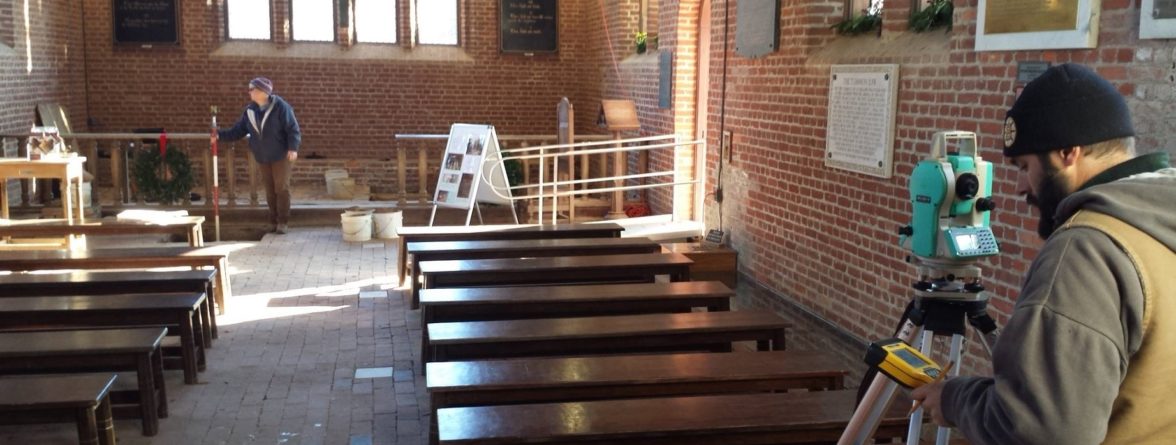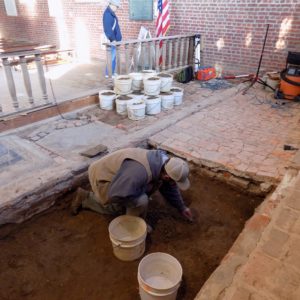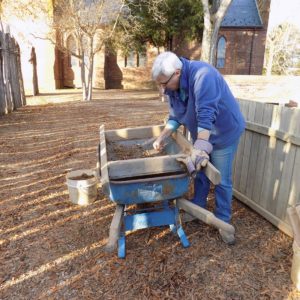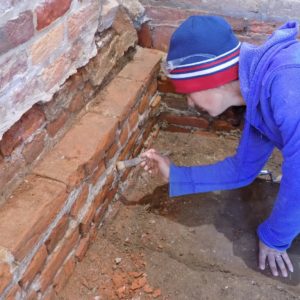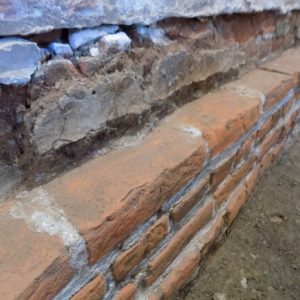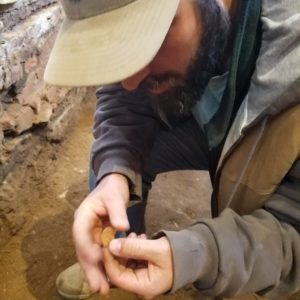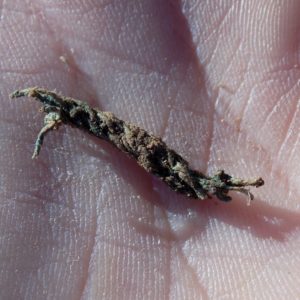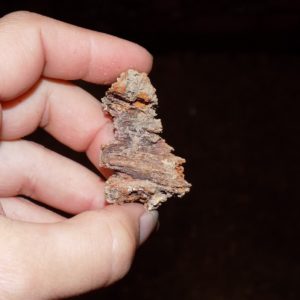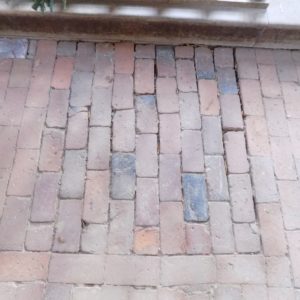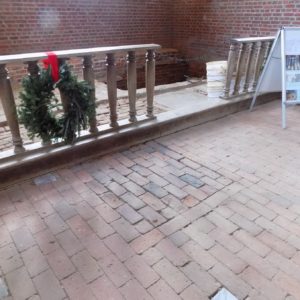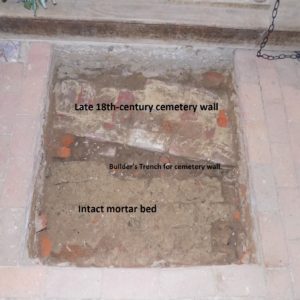Periodically and weather permitting, the Jamestown Rediscovery archaeological staff is continuing field work during the winter months. Our primary focus is to expand excavations in the 20th-century Memorial Church. The team has garnered new insights into what they may encounter through studies of the 1901-1905 excavation notes recorded by founders of the Association for the Preservation of Virginia Antiquities (APVA Preservation Virginia). However, their handwritten notes omitted certain details, especially how they left the site, and current excavations will answer our questions.
In December, archaeologists worked in the 6’ by 10’ test in the southeast corner of the chancel. After removing tiles and bricks placed in the chancel in 1902, they excavated the largest and thickest layer soil. This sandy loam layer is backfill or archaeological till from the early 20th-century excavations. The team found fragments of mortar and plaster related to construction and deconstruction of all three churches built in the same location, as well as several iron coffin nails and copper alloy straight pins. These were likely missed or discarded by excavators, who were unaware of their significance in relation to the skeletal remains they recorded in the area.
Apparently, the original APVA excavators did not screen soils like today’s archaeologists, thus a number of small ceramic sherds have been recovered during current excavations. Many of the artifacts most likely relate to occupation in the location before the first church was constructed in 1617. Sherds of Chinese porcelain, Surrey-Hampshire Border ware, North Devon, Frechen brown salt-glazed stoneware, and Roanoke simple-stamped pottery were found in the screened soil. Among the most notable artifacts recovered is an iron hanger from a sword belt. Finally, a small, flat-sectioned bone disc was recovered, which is believed to be an early gaming piece.
The early APVA records note that large pottery sherds and oyster shells were found in the graves. They theorized that the colonial grave diggers had used these to stabilize and level the coffins as they lowered them into the shafts. However, since the Rediscovery team has located the original James Fort palisade and its 1608 addition, we are more informed about the types of features that may have been in this location prior to the church. The large pottery sherds and oyster shells were most likely refuse from an early 17th-century pit or cellar that was backfilled before the 1617 church was constructed. The artifacts were subsequently encountered by 17th-century grave diggers, and were tossed back into grave shafts as they were backfilled.
The southeast corner of the church foundation was also revealed in this test. After removing the tile floor in November, the team found the 4” offsets for the 1640s church wall as described by engineer John Tyler, Jr. in his letter to the Chairman of the APVA Jamestown Committee. In addition to the offsets, they noted that small sections of wall plaster survived on some of the interior sections of the east wall. This plaster is related to either the 1640s church, or to the church that was rebuilt following the Bacon’s Rebellion fire in 1676. Based on the early 20th-century descriptions of the desolate state of the church ruins, it is incredible that any of it survives at all!
Unfortunately, archaeologists found no evidence of the 1617 church foundation in the southeast corner test. It is believed it was destroyed by burials that occurred in the area in the later 17th-century. Evident along the center of the south wall, surviving sections of the 1617 foundation are above the depth we have reached in current excavations, now approximately 3’ below the tile floor. At this depth, the bottoms of the 1640s brick church south wall and east wall have been identified. However, backfill continues in depth, and will likely end at the bottom of the graves uncovered during the early 20th-century excavations.
Concurrently, the team opened a small test unit in the aisle of the body of the church to explore other early 20th-century excavations. A square-shaped area of dry-laid bricks was excavated in the search for its explanation. After removing the bricks and sand, archaeologist Bob Chartrand discovered a portion of a cemetery wall that was built in the eighteenth century after the church became a ruin. He also found its builder’s trench, and a section of undisturbed, intact mortar. Chartrand’s excavation revealed that the bricks from the wall had been removed, and that they were oriented north-south, in a direction opposite of any others found during previous excavations in the aisle. This area may have been originally intended for use as a display under glass, much like the south and north 17th-century church walls are shown under glass in the Memorial Church.
Check out our most recent video with field supervisor Mary Anna Hartley for some footage of the church excavations.
related images
- Archaeologist Bob Chartrand starts down into the backfill left from previous excavations conducted in 1901-1902.
- Amy Baker screens some of backfill.
- Mary Anna Hartley cleans the mortar joints on the brick foundation for the 1640s church.
- The 4 inch offset mentioned by engineer John Tyler, Jr. in 1901. The width of a brick or half the length of a brick.
- Bob Chartrand points to plaster that remains adhered to the east foundation wall. The brick you see above his finger was added post early 20th-century excavations.
- Archaeologist Bob Chartrand examines the bone disc he just uncovered in the church.
- Bone disc, likely a game piece.
- Piece of thread preserved by the copper salts of the aglet that once held it.
- Iron hanger for a sword belt.
- Possible coffin nail with wood impression.
- Test in the body of the church where bricks were left unmortared.
- Looking at the test with the unmortared bricks.
- Bob Chartrand excavates the test in the body of the church.
- The discovery of the cemetery wall, its builder’s trench and intact mortar for the bricks that once made up the church floor.
- Amy Baker and Bob Chartrand map the test unit in the body of the church.


